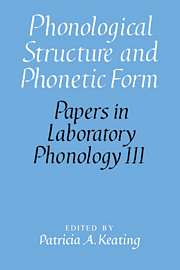Book contents
- Frontmatter
- Contents
- List of contributors
- Acknowledgments
- 1 Introduction
- I Intonation
- II Syllables
- 8 Articulatory phonetic clues to syllable affiliation: gestural characteristics of bilabial stops
- 9 The phonology and phonetics of extrasyllabicity in French
- 10 Phonetic correlates of syllable affiliation
- 11 Syllable structure and word structure: a study of triconsonantal clusters in English
- III Feature Theory
- IV Phonetic Output
- Index of subjects
- Index of names
9 - The phonology and phonetics of extrasyllabicity in French
Published online by Cambridge University Press: 26 February 2010
- Frontmatter
- Contents
- List of contributors
- Acknowledgments
- 1 Introduction
- I Intonation
- II Syllables
- 8 Articulatory phonetic clues to syllable affiliation: gestural characteristics of bilabial stops
- 9 The phonology and phonetics of extrasyllabicity in French
- 10 Phonetic correlates of syllable affiliation
- 11 Syllable structure and word structure: a study of triconsonantal clusters in English
- III Feature Theory
- IV Phonetic Output
- Index of subjects
- Index of names
Summary
A central goal of Laboratory Phonology is to improve our understanding of the relationship between phonological representations and their phonetic interpretation. From this point of view, extrasyllabicity presents an interesting case. An extrasyllabic consonant is not part of any syllable. This notion was introduced by Clements and Keyser in CV Phonology (1983) and is now widely used among phonologists. However, no systematic study has yet been carried out of the phonetic implementation of this notion or of its correlate, core syllabification. This question has been raised in regard to English data in recent work, but not as a central concern (see Browman and Goldstein 1988, as well as Fujimura and Lovins 1978 for a related perspective).
The case of French is a particularly interesting one. Unlike English, French has phonological rules sensitive to extrasyllabicity. While many of these rules are lexical, some of them, including a rule involving a constraint on geminates to be discussed below, are postlexical. If phonological rules can refer to extrasyllabicity, we would expect to find phonetic correlates of this notion as well. Among other things, we will see that extrasyllabic consonants do not exhibit the high degree of coarticulation with following segments that is typical of onset consonants. Other processes, such as voicing assimilation and cluster timing, will be seen to depend not only on syllable organization, but also on the way extrasyllabic consonants are affiliated to larger constituents such as the word and phrase, allowing a better understanding of the nature of extrasyllabicity.
This paper focuses mainly on word-initial consonants. In section 9.1, we consider the status of word-initial consonants, and offer phonological evidence in favor of extrasyllabicity.
- Type
- Chapter
- Information
- Phonological Structure and Phonetic Form , pp. 136 - 159Publisher: Cambridge University PressPrint publication year: 1994
- 11
- Cited by



